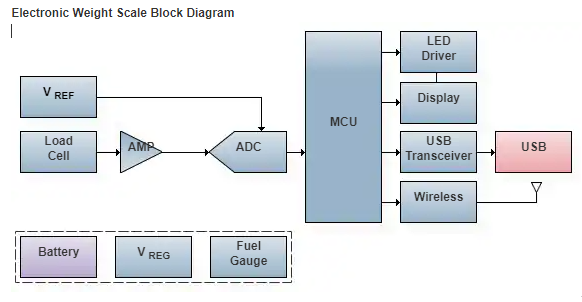Medical
Featured Medical Application - Electronic Weight Scale
Over two-thirds of U.S. adults weigh more than they should, estimates the U.S. Department of Health and Human Services. But regardless of country, obesity has generally been a growing concern among the health-conscious – and, of course, most body weight management plans will at least require one instrument: the weigh scale.
A typical electronic scale senses weight using one or more load-cells and a bridge circuit. The resulting differential signal is several orders of magnitude less than the excitation voltage, so a filter and amplifier are common requirements. Ideally, a delta-sigma ADC (analog-to-digital converter) with 14 or more bits of precision is used, while a low-power MCU is selected to provide post-processing, interpretation, and control of peripherals.
Major subsystems include:
- Load cells and bridge circuit
- Analog Front End (AFE) including filter and amplifier
- ADC
- MCU
- Power Management
Common practice dictates that the system’s internal resolution count should be at least 10 times the desired external count, i.e. what the user sees on the display. An ADC with the appropriate resolution and dynamic range must be selected.
Noise rejection is a key consideration and so the AFE should be decoupled from the digital supply. While a delta-sigma ADC will help eliminate quantization noise, a low-pass filter can be used before A/D conversion to reduce noise from the load cells. To preserve accuracy, the gain stage which amplifies the low-level signal should have very low gain drift and the ADC should be ratiometric with respect to the bridge excitation.

This design is for reference only. The design, as well as the products suggested, has not been tested for compatibility or interoperability.